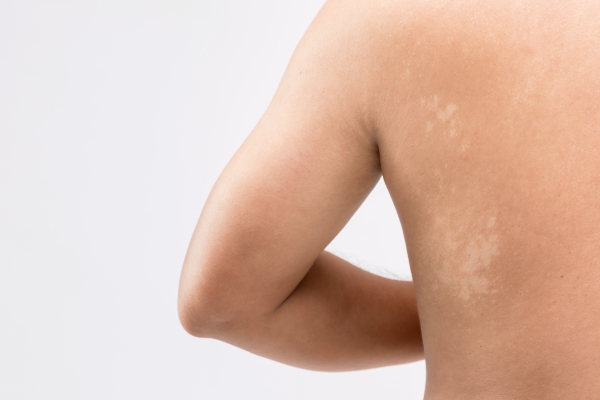What is Tinea versicolor?
Tinea versicolor, also known as Pityriasis versicolor, is a common and benign superficial skin infection that is caused by a fungus that presents typically with hypopigmented (lighter than surrounding skin) or hyperpigmented (darker than surrounding skin) patches on the chest and back. In some people, the patches may look inflamed. It is caused by a fungus called Malassezia.
Malassezia is normally found on human skin. However, some factors cause it to convert in a disease causing form. These may include genetic factors, weakened immune system, malnutrition, pregnancy, and other environmental factors. Tinea versicolor is a skin condition that is present worldwide, however, it occurs mostly in tropical climates. Up to 50% of the population may be affected in tropical countries. It is more common among young adults and adolescents, but may also arise in children or infants. It is not a contagious disease thus cannot be transmitted from one person to another.
Tinea versicolor is a skin condition that responds well to medical therapy without any complications. However, in many people, it tends to recur and long term therapy may be indicated.
What causes Tinea versicolor?
Tinea versicolor is a benign fungal infection of the skin. It is caused by a fungus of the Malassezia family. There are about 3 main Malassezia species that causes tinea versicolor including Malassezia globosa, Malassezia sympodialis, and Malassezia furfur. Malassezia is naturally present on normal skin. The exact reason why some people with the fungus develop the disease while others do not is not entirely known.

What are the risk factors for Tinea versicolor?
There are several factors that can contribute to the conversion of the fungus into the pathologic form. These factors include:
- Warm and humid environments
- Weakened immune system
- Malnutrition
- Genetic predisposition
- Application of oily preparations on the skin
- Use of corticosteroid medications
- Cushing disease
- Use of bath oils and skin lubricants
- Sun exposure
Tinea versicolor is not associated with poor hygiene.
What are the symptoms of Tinea versicolor?
The following symptoms are usually present in Tinea versicolor:
- Hypopigmented or hyperpigmented skin patches most commonly present on the trunk, back, abdomen and limbs.
- Dust-like scale covering the lesions.
- Lesions becoming more apparent with sun exposure
- Mild itching

How is the diagnosis of Tinea versicolor made?
To make the diagnosis of tinea versicolor, your doctor will start by taking a history from you. He/she will then proceed with a physical examination focusing on the skin lesions. The diagnosis of tinea versicolor is usually made clinically as the presentation is characteristic. However, if the diagnosis is doubtful, some tests may be performed to confirm the diagnosis. These include:

- Wood lamp: In this procedure, an ultraviolet black light is used to illuminate the skin lesions. In the case of tinea versicolor, the lesions appear as a coppery-orange fluorescence.
- Potassium hydroxide (KOH) examination: In this procedure, samples of your skin are obtained by scraping the lesions. These samples are placed on a microscope slide covered by potassium hydroxide. This slide is then observed under a microscope to look for the fungus.
How is Tinea versicolor treated?
First of all, you should know that tinea versicolor is not a contagious disease. The condition does not leave any permanent scaring or skin changes. The time taken for the condition to resolve vary from person to person.
The mainstay of treatment for tinea versicolor is topical antifungals. Some examples include the following agents:
- Selenium sulfide
- Zinc-pyrithione
- Sodium sulfacetamide
- Ciclopirox olamine
- Tacrolimus
- Azoles such as clotrimazole or miconazole
- Allylamine
Selenium sulfide lotions are usually used on affected areas every day for 2 weeks. It is recommended to leave the lotion on for around 10 minutes before being washed off. If you have a resistant form of the skin lesions, overnight application may be more effective. Topical azole antifungals may also be used every night for 2 weeks. Selenium sulfide and zinc-pyrithione are also available in the form of shampoos.

In some cases, your doctor may recommended the use of oral antifungal medications. If you have recurrence, topical medications may have to be used intermittently to prevent having the disease again especially during warm and humid months.
What is the prognosis for Tinea versicolor?
Tinea versicolor is a benign and non-contagious skin condition that responds well to treatment. Improvement may be seen a few days within initiation of treatment. In some cases, the discoloration may last for a few more weeks or months. Recurrence is also common in the course of the disease. Overall, the prognosis for tinea versicolor is excellent.

Source:
Gupta AK, Batra R, Bluhm R, Faergemann J. Pityriasis versicolor. Dermatol Clin 2003; 21:413.
Gupta AK, Bluhm R, Summerbell R. Pityriasis versicolor. J Eur Acad Dermatol Venereol 2002; 16:19.
Goldstein, B and Goldstein, A., 2020. Tinea versicolor (Pityriasis versicolor)
Sayed, C., 2020. Tinea Versicolor




